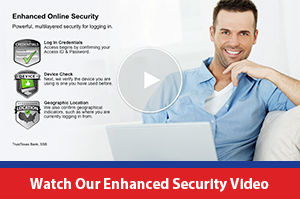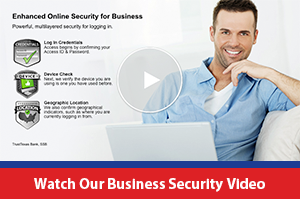FDIC-Insured - Backed by the full faith and credit of the U.S. Government
FDIC-Insured - Backed by the full faith and credit of the U.S. Government
CybersecurityCybersecurity education is vital in today’s technology-driven world. We want to help you stay safe online with tips and resources you can use.
|
MoneyiQ |
General Online Safety Tips and Resources |
National Cybersecurity Awareness Month October is Cybersecurity Awareness Month, a global effort to help everyone stay safe and protected when using technology whenever and however you connect. The theme for the month is, ‘Secure Our World’ and TrustTexas Bank is proud to be a champion and support this online safety and education initiative this October. Cybersecurity Awareness Month is designed to engage and educate public- and private-sector partners through events and initiatives with the goal of raising awareness about cybersecurity to increase the resiliency of the nation in the event of a cyber incident. Since the Presidential proclamation establishing Cybersecurity Awareness Month in 2004, the initiative has been formally recognized by Congress, federal, state, and local governments and leaders from industry and academia. This united effort is necessary to maintain a cyberspace that is safer and more resilient and remains a source of tremendous opportunity and growth for years to come. For more information, visit https://www.cisa.gov/cybersecurity-awareness-month and staysafeonline.org/cybersecurity-awareness-month/ From mobile to connected home devices, technology is deeply intertwined with our lives. And while the evolution of technology accelerates, cybercriminals are working just as hard to find ways to compromise technology and disrupt personal and business life. For 20 Octobers and counting, Cybersecurity Awareness Month aims to highlight some of the emerging challenges that exist in the world of cybersecurity today and provide straightforward actionable guidance that anyone can follow to create a safe and secure digital world for themselves and their loved ones.
Cybersecurity Awareness Month continues to build momentum and impact with the goal of providing everyone with the information they need to stay safer and more secure online. TrustTexas Bank is proud to support this far-reaching online safety awareness and education initiative which is co-managed by the National Cyber Security Alliance and the Cybersecurity and Infrastructure Agency (CISA) of the U.S. Department of Homeland Security. |
Simple Steps to Online SafetyStaying safe and secure online is our shared responsibility. Here is easy-to-follow, actionable advice for everyone.
It is critical for anyone using the internet to continually learn about and consistently practice good cybersecurity habits. To better protect yourself, you should secure your home networks and mobile devices and take the time to learn how to use the internet more safely, securely and responsibly. View these tip sheets to address the top consumer cyber concerns, provide simple steps to protect against these concerns and teach you what to do if you fall victim to cybercrime. Online Cybersecurity Tip Sheet For All Digital Citizens
More Cybersecurity TipsUnderstand your digital profile.Internet-based devices are present in every aspect of our lives: at home, school, work, and on the go. Constant connection provides opportunities for innovation and modernization, but also presents opportunities for potential cybersecurity threats that can compromise your most important personal information. Understand the devices and applications you use every day to help keep you and your information safe and secure.
Tip Sheets:
Secure your digital profile.Cybercriminals are very good at getting personal information from unsuspecting victims, and the methods are getting more sophisticated as technology evolves. Protect against cyber threats by learning about security features available on the equipment and software you use. Apply additional layers of security to your devices – like Multi-Factor Authentication – to better protect your personal information.
Tip Sheets: Creating A Password
Maintain your digital profile.Every click, share, send, and post you make creates a digital trail that can be exploited by cybercriminals. To protect yourself from becoming a cybercrime victim you must understand, secure, and maintain your digital profile. Be familiar with and routinely check privacy settings to help protect your privacy and limit cybercrimes.
Tip Sheets: Social Media Bots Overview |
Cybersecurity in the WorkplacePrivacy is Good for Business |
Cybersecurity for Older AdultsCyber Tips for Older Americans |
PC-Related Threats:
|
Ways to Prevent Infection:
|

